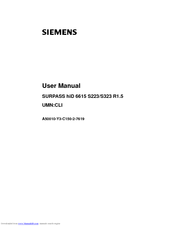Siemens S323 Manuals
Manuals and User Guides for Siemens S323. We have 1 Siemens S323 manual available for free PDF download: User Manual
Siemens S323 User Manual (381 pages)
Siemens Single-Board Fast Ethernet Switch Operators User Manual
Brand: Siemens
|
Category: Network Hardware
|
Size: 9.75 MB
Table of Contents
-
-
Command Mode27
-
Useful Tips36
-
-
-
System Login40
-
Auto Log-Out48
-
SSH Server61
-
SSH Client62
-
File Copy62
-
-
Port Basic73
-
Duplex Mode76
-
Flow Control76
-
Port Status80
-
-
-
Host Name83
-
Time Zone84
-
Login Banner87
-
DNS Server87
-
CPU Load88
-
Port Traffic89
-
Auto-Saving92
-
MAC Table99
-
CPU Packet Limit101
-
Running Process101
-
Default os102
-
Switch Status103
-
Tech Support103
-
-
SNMP Community104
-
SNMP Com2Sec106
-
SNMP Group106
-
SNMP View Record107
-
SNMP Trap108
-
SNMP Trap Host109
-
SNMP Trap Mode109
-
SNMP Alarm112
-
Disabling SNMP118
-
OAM Loopback119
-
Local OAM Mode120
-
OAM Unidirection120
-
Remote OAM120
-
LLDP Operation123
-
Basic TLV123
-
LLDP Message124
-
RMON History126
-
RMON Alarm129
-
RMON Event132
-
Event Community132
-
Event Type133
-
Syslog135
-
Facility Code137
-
Disabling Syslog138
-
Rule and Qos139
-
Rule Creation140
-
Rule Priority140
-
Rule Action143
-
Applying Rule145
-
Displaying Rule146
-
Qos146
-
Qos Weight149
-
Queue Parameter150
-
Displaying Qos150
-
Rule Creation151
-
Rule Priority151
-
Rule Action153
-
Applying Rule153
-
Displaying Rule154
-
Max Host156
-
Max New Hosts157
-
Port Security158
-
MAC Table161
-
MAC Filtering163
-
ARP Table165
-
ARP Alias167
-
ARP Inspection167
-
Gratuitous ARP169
-
Proxy-ARP169
-
Packet Dump174
-
-
Vlan178
-
Port-Based VLAN179
-
Creating VLAN180
-
Specifying PVID180
-
Deleting VLAN180
-
Displaying VLAN181
-
Tagged VLAN182
-
VLAN Description183
-
Qinq184
-
Port Isolation187
-
Shared VLAN187
-
VLAN Translation189
-
Link Aggregation192
-
Port Trunk193
-
Configuring LACP195
-
Packet Route195
-
STP Operation201
-
RSTP Operation205
-
MSTP Operation209
-
Root Switch212
-
Path-Cost212
-
Port-Priority213
-
MST Region214
-
MSTP Protocol215
-
Edge Ports215
-
Root Switch218
-
Path-Cost218
-
Port-Priority218
-
Root Guard219
-
Hello Time220
-
Forward Delay221
-
Max Age221
-
BPDU Hop222
-
BPDU Filter222
-
BPDU Guard222
-
Configuring VRRP228
-
Preempt233
-
VRRP Statistics234
-
Rate Limit234
-
Flood Guard236
-
Bandwidth237
-
DHCP Server239
-
DHCP Subnet240
-
Default Gateway241
-
IP Lease Time241
-
DNS Server242
-
Manual Binding242
-
Domain Name243
-
Static Mapping243
-
Authorized ARP244
-
DHCP Relay Agent250
-
DHCP Option 82252
-
DHCP Client256
-
DHCP Client ID256
-
DHCP Class ID256
-
Host Name256
-
IP Lease Time257
-
DHCP Snooping258
-
DHCP Trust State258
-
DHCP Rate Limit259
-
DHCP Lease Limit259
-
IP Source Guard261
-
DHCP Filtering263
-
Debugging DHCP264
-
ERP Operation265
-
Configuring ERP267
-
ERP Domain267
-
RM Node268
-
Protected VLAN268
-
Stacking270
-
Switch Group271
-
-
9 IP Multicast
278-
MRIB Debug281
-
Multicast Aging282
-
IGMP Debug284
-
IGMP Version 2284
-
L2 Mfib288
-
IGMP V2 Snooping289
-
Mrouter Port294
-
IGMP V3 Snooping297
-
Immediate Block298
-
Enabling MVR299
-
MVR IP Address299
-
DR Priority305
-
PIM Hello Query306
-
PIM Debug307
-
BSR and RP307
-
RP Information308
-
SPT Switchover312
-
PIM-SSM Group315
-
PIM Snooping315
-
-
Summary of Path320
-
Graceful Restart323
-
BGP Neighbor325
-
Default Route325
-
Peer Group325
-
Route Map326
-
Force Shutdown326
-
Enabling OSPF333
-
OSPF Interface335
-
Interface Cost337
-
OSPF Priority340
-
OSPF Area342
-
Area Range346
-
Shortcut Area346
-
Stub Area347
-
Virtual Link347
-
Default Metric349
-
Default Route351
-
Finding Period352
-
OSPF Distance354
-
Host Route355
-
Enabling RIP361
-
RIP Version363
-
Offset List368
-
Split Horizon370
-
Restarting RIP371
-
-
General Upgrade373
-
FTP Upgrade377
-
-
12 Abbreviations
379
Advertisement
Advertisement
Related Products
- Siemens SANTIS-ab
- Siemens SICAM SGU 7XV5676
- Siemens SIMATIC NET SCALANCE W788-2RR
- Siemens SIMATIC NET SCALANCE W747-1RR
- Siemens SIMATIC PN/CAN LINK
- Siemens SCALANCE S615 EEC
- Siemens SIMATIC NET RUGGEDCOM APE
- Siemens SIMATIC NET SCALANCE X-100 Series
- Siemens SIMATIC NET SCALANCE W788-1RR
- Siemens SIMATIC NET PROFIBUS OBT
